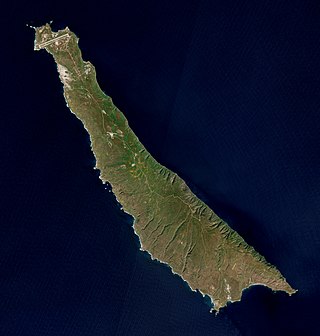
San Clemente Island is the southernmost of the Channel Islands of California. It is owned and operated by the United States Navy, and is a part of Los Angeles County. It is administered by Naval Base Coronado. It is 21 miles (34 km) long and has 147.13 km2 (56.81 sq mi) of land. The 2018 census estimates 148 military and civilian personnel reside on the island. The city of San Clemente in Orange County, California is named after the island.
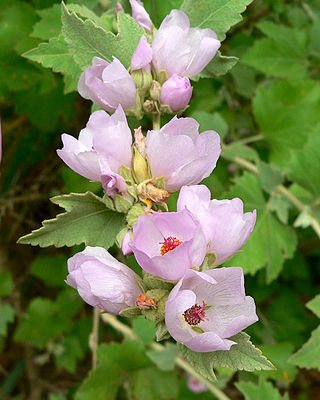
Malacothamnus (bushmallow) is a genus of shrubs found throughout much of mainland California and on three of the Channel Islands. Outside of California, Malacothamnus is known from the northern half of Baja California and from a few disjunct locations in Arizona. Plants of this genus are most commonly found in early-successional, post-burn plant communities. Malacothamnus are currently thought to be most closely related to the Iliamnas of the US interior and the Phymosias of Mexico, Central America, and the Caribbean.
Hazardia cana is a rare North American species of shrubs in the family Asteraceae known by the common names Guadalupe hazardia, San Clemente Island hazardia, or simply island hazardia. It is native to San Clemente Island, one of the Channel Islands of California, and to Guadalupe Island.
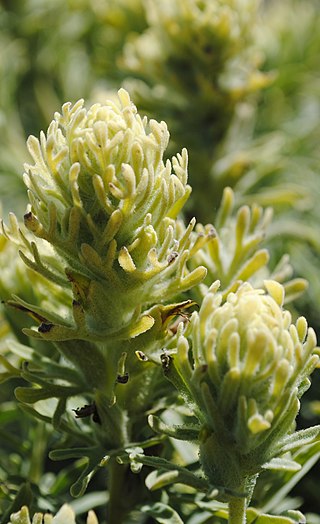
Castilleja grisea is a rare species of Indian paintbrush known by the common name San Clemente Island Indian paintbrush. It is endemic to San Clemente Island, one of the Channel Islands of California. San Clemente Island is owned by the US Navy so the Navy is involved in a management program to recover this species.
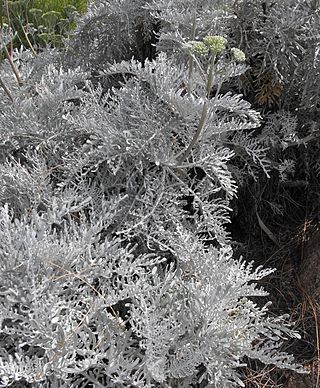
Constancea is a monotypic genus of flowering plants in the family Asteraceae containing the single species Constancea nevinii, which is known by the common name Nevin's woolly sunflower. It is endemic to three of the Channel Islands of California, where it grows in coastal scrub habitat. This is a small shrub or subshrub generally growing up to one or 1.5 meters tall, and taller when an erect form, with a branching, woolly stem. The whitish, woolly oval leaves may be up to 20 centimeters long and are divided into many narrow lobes with edges curled under. The inflorescence is a cluster of 10 to 50 or more small flower heads, each on a short peduncle. The flower head has a center of hairy, glandular, star-shaped yellow disc florets and a fringe of four to nine yellow ray florets, each about 2 millimeters long. The fruit is an achene a few millimeters long with a small pappus at the tip.
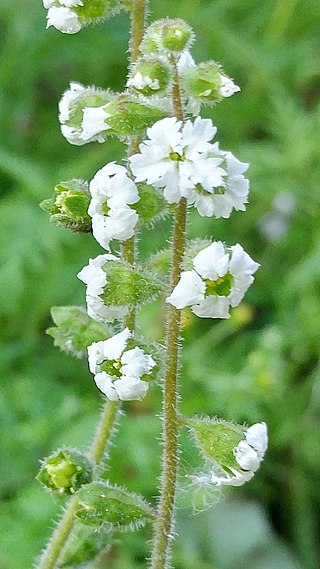
Lithophragma maximum, known by the common name San Clemente Island woodland star, is a rare species of flowering plant in the saxifrage family. It is endemic to San Clemente Island, one of the eight Channel Islands of California. It is known from only about four kilometers of rocky coastal cliffs on the edge of the island. The plant was thought to be extinct until a few specimens were rediscovered in 1979. Only 200 individuals were tallied in a 1996 survey. In 1997 the plant was listed as an endangered species on the federal level.

Acmispon dendroideus, synonym Syrmatium veatchii, is a species of legume native to California. It is known by the common name island broom. It is endemic to the Channel Islands of California, where it grows on coastal bluffs and cliffs. It is a spreading perennial herb or erect shrub approaching 2 meters in height. It is hairless to hairy and gray-green in color. The branches lined with leaves each made up of a few oval leaflike leaflets up to 1.5 centimeters long each. The inflorescence bears up to 10 yellow pealike flowers, each roughly a centimeter long and fading red as they age.
Malacothamnus abbottii is a rare species of flowering plant in the mallow family known by the common name Abbott's bushmallow. It is endemic to Monterey County, California, where it has recently been observed at only a few locations. It was historically known from a single specimen collection and the plant was presumed extinct until it was rediscovered in 1990 near San Ardo in the Salinas River drainage. It is now known from eleven occurrences, many of which are actually part of a single population, growing in vulnerable riverbeds near oil fields. Its habitat is periodically flooding riparian scrub among sandbar willows. This is a shrub with a slender, branching stem growing erect to a maximum height over one meter. It is coated in thin white hairs and bears toothed oval leaves a few centimeters long, sometimes divided into lobes. The inflorescence is a cluster of a few pale pink flowers with pointed oval petals 6 or 7 millimeters long.
Malacothamnus aboriginum is a species of flowering plant in the mallow family known by the common name Indian Valley bushmallow. It is endemic to the southern Coastal Ranges of California, primarily in the southern half of the Diablo Range and the Gabilan Range. Plants from San Diego County called Malacothamnus aboriginum in the past were described as the new species Malacothamnus enigmaticus in 2019.

Malacothamnus davidsonii is a species of flowering plant in the mallow family known by the common names Tujunga bushmallow and Davidson's bushmallow. It is endemic to Los Angeles County, California, where it primary occurs in and near Big Tujunga Canyon, Little Tujunga Canyon, and Tujunga Wash. The common name Tujunga bushmallow alludes to its geographic distribution. Plants of what has historically been considered Malacothamnus davidsonii from Monterey and San Luis Obispo counties in California were described as the new species Malacothamnus discombobulatus in 2023 based on phylogenetic, morphological, and geographic evidence.
Malacothamnus densiflorus is a species of flowering plant in the mallow family, which has two varieties. It is endemic to the Peninsular Ranges of southwestern California and northwestern Baja California.
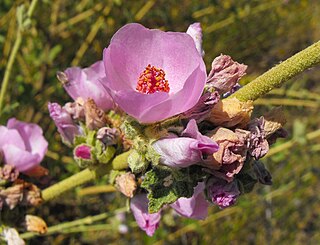
Malacothamnus fasciculatus is a species of flowering plant in the mallow family, which has four varieties. It is endemic to southwestern California and northwestern Baja California.
Malacothamnus jonesii is a species of flowering plant in the mallow family which has three varieties, two of which are sometimes recognized at the species rank as Malacothamnus gracilis and Malacothamnus niveus. Malacothamnus jonesii is endemic to San Luis Obispo County, California and just over its northern and southern borders in Monterey and Santa Barbara counties.
Munzothamnus is a monotypic genus of flowering plants in the family Asteraceae containing the single species Munzothamnus blairii, which is known by the common name Blair's wirelettuce, or Blair's munzothamnus. It is endemic to San Clemente Island, one of the Channel Islands of California. It grows along steep, rocky cliffsides and canyons on the island. It is a shrub producing a fleshy, woolly stem usually over a meter in height, often approaching two meters. Leaves occur in tufts at the ends of the stem branches. They are up to 15 centimeters long, oblong in shape, and sometimes very shallowly lobed. They are woolly when new but lose their hairs and become shiny green with age. The inflorescence is a large array of up to 35 flower heads. Each head has a cylindrical base under a centimetre long and contains 9 to 12 light lavender or pinkish flowers. Each flower is a ray floret with an erect tube and a strap-shaped ligule with a toothed tip. The ligule is just under a centimetre long. The fruit is a cylindrical, ribbed achene with a white pappus.

Sibara filifolia, the Santa Cruz Island winged rockcress or Santa Cruz Island rockcress, is a rare species of flowering plant in the family Brassicaceae. It is endemic to the Channel Islands of California, where it is now known from a few occurrences on San Clemente Island and one population on Catalina Island.

Triteleia clementina is a rare species of flowering plant known by the common name San Clemente Island triteleia. It is endemic to San Clemente Island, one of the Channel Islands of California, where it is known from about twenty occurrences. Its habitat includes moist, rocky, seaside grassland. It is a perennial herb growing from a corm. It produces two or three keeled, lance-shaped leaves up to 100 centimeters long by three wide. The inflorescence arises on an erect stem up to 90 centimeters tall and bears an umbel-like cluster of many flowers. Each flower is a funnel-shaped lavender or light blue bloom with six lobes measuring up to 1.5 centimeters long. There are six stamens with purple anthers.
The wildlife of the Channel Islands of California is wide and diverse, including many endemic species. While the land wildlife is slightly limited, there being only one large, naturally predatory, and native mammal, the small island fox, marine life can include anything from kelp forests to great white sharks.
Malacothamnus mendocinensis is a species of flowering plant in the mallow family known by the common name Mendocino bushmallow. It is endemic to Mendocino County, California, where it is known from only two populations. It was presumed extinct until rediscovered in 2016 and now has a California Rare Plant Rank of 1B.1. In some treatments, Malacothamnus mendocinensis has been included within Malacothamnus fasciculatus or Malacothamnus hallii. Phylogenetic and morphological evidence, however, indicate that it is not closely related to these species and should be recognized as a separate species.
Malacothamnus arcuatus is a species of flowering plant in the mallow family, which has two varieties, one of which is sometimes recognized as the species Malacothamnus hallii.
Malacothamnus parishii is a species of flowering plant in the mallow family known by the common name Parish's bushmallow. It is endemic to San Bernardino County, California, where it is confirmed from only a single collection from 1895. It has a California Rare Plant Rank of 1A. Malacothamnus parishii is currently treated as an extreme form of Malacothamnus fasciculatus var. laxiflorus. Phylogenetic analyses are needed to confirm whether it should be treated as a separate species or not.











